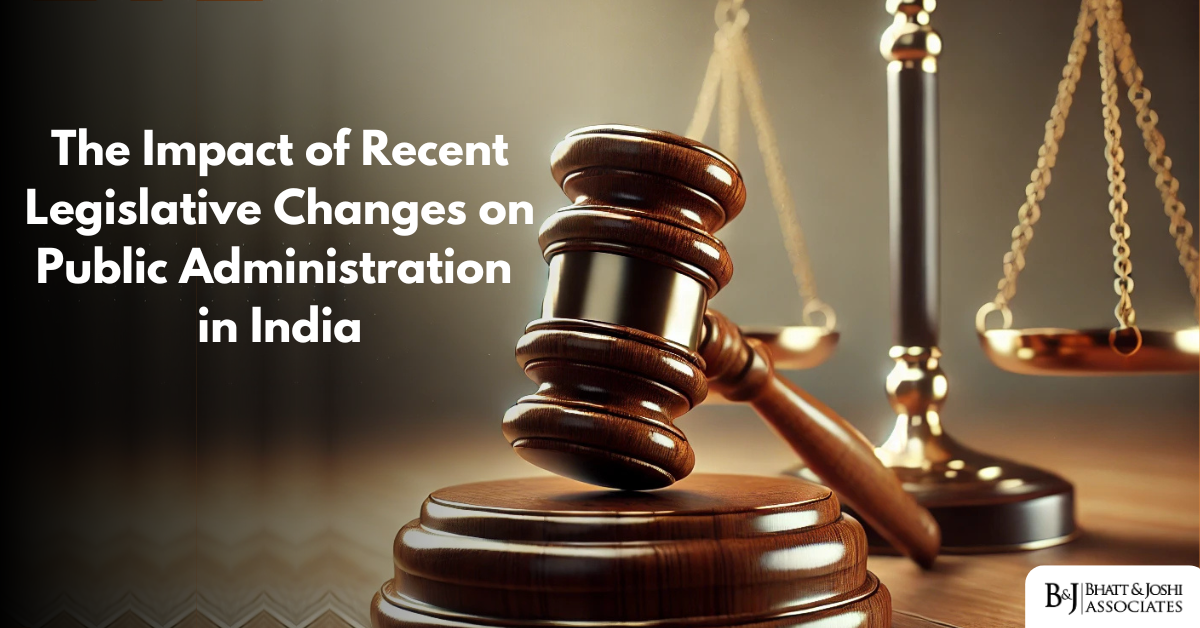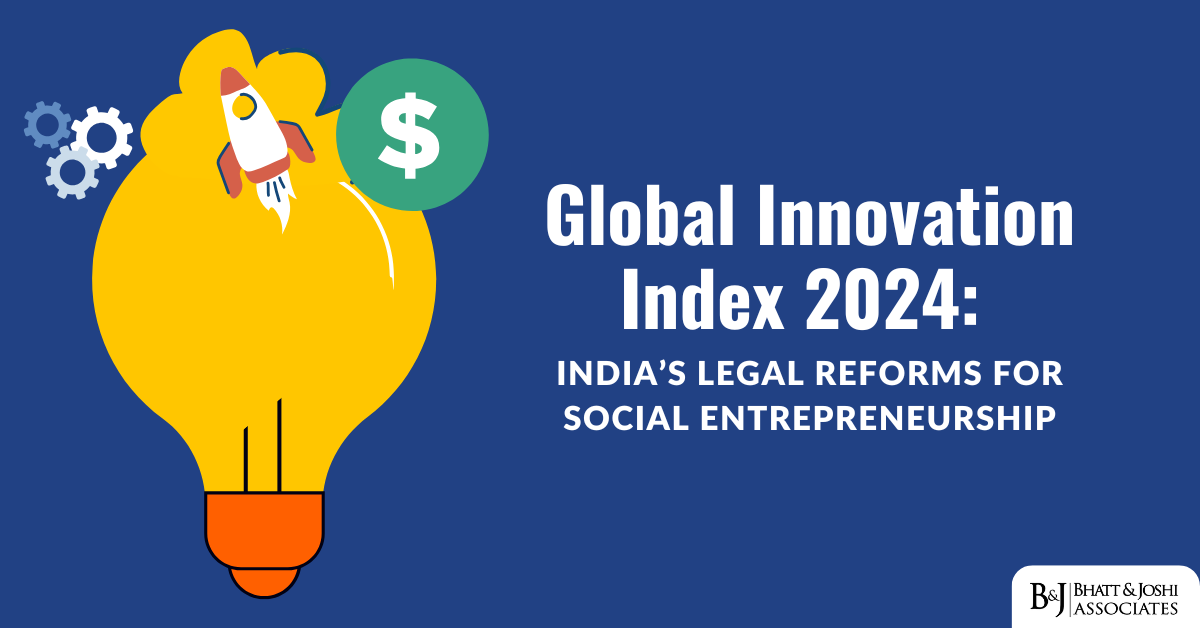Introduction
Public administration in India serves as the backbone of governance, ensuring the implementation of policies, maintenance of law and order, and delivery of public services. In recent years, legislative changes in India have significantly influenced the dynamics of public administration, leading to reforms in efficiency, transparency, and accountability. This article explores the impact of these recent legislative changes, delving into the regulatory frameworks, key legislation, and landmark judgments that have shaped the landscape of governance in India. We also examine the broader implications of these changes, the challenges they present, and the pathways for future reforms.
Impact of Legislative Reforms on Public Administration
India has witnessed a wave of legislative reforms aimed at modernizing public administration. These reforms have touched upon diverse aspects, including anti-corruption measures, digital governance, environmental regulation, and decentralization of power. The introduction of these recent legislative changes has sought to address systemic inefficiencies, ensure accountability, and promote participatory governance.
The Right to Information Act, 2005
One of the most transformative pieces of legislation affecting public administration is the Right to Information (RTI) Act, 2005. The RTI Act empowers citizens to seek information from public authorities, thereby promoting transparency and accountability. This law has led to significant improvements in administrative efficiency, as officials are now more cautious in their decision-making processes to avoid scrutiny.
The RTI Act’s transformative power is evident in its widespread use by citizens, activists, and journalists to uncover corruption and inefficiencies. However, its implementation has faced resistance from bureaucracies reluctant to share information, citing confidentiality concerns. Despite these challenges, the RTI Act remains a cornerstone of participatory governance.
In the landmark case of State of Uttar Pradesh v. Raj Narain (1975), the Supreme Court of India held that the right to know is a fundamental right under Article 19(1)(a) of the Constitution. This judgment paved the way for the enactment of the RTI Act. While the Act has succeeded in empowering citizens, misuse of the law and delays in information dissemination remain challenges, necessitating further reforms and digital integration for faster responses.
The Goods and Services Tax (GST) Act, 2017
The implementation of the GST Act marked a paradigm shift in India’s indirect taxation system. It subsumed multiple taxes into a unified framework, simplifying the tax structure and fostering cooperative federalism. For public administration, GST has improved revenue collection efficiency and reduced tax evasion, allowing better allocation of resources for public services.
Judicial scrutiny has played a vital role in the evolution of GST. In Mohit Minerals Pvt. Ltd. v. Union of India (2022), the Supreme Court upheld the principle of cooperative federalism inherent in the GST framework, emphasizing the importance of collaboration between the Centre and states. Despite its successes, the implementation of GST has faced challenges such as compliance burdens for small businesses and technical glitches in the GST Network (GSTN).
Decentralization and Local Governance
The 73rd and 74th Constitutional Amendments were milestones in decentralizing governance by empowering Panchayati Raj Institutions (PRIs) and Urban Local Bodies (ULBs). Recent legislative changes have further strengthened this framework, ensuring greater financial and administrative autonomy for local bodies.
Strengthening of PRIs
The introduction of schemes like the Rashtriya Gram Swaraj Abhiyan (RGSA) has enhanced the capacity of PRIs to deliver public services effectively. Legislative changes have also promoted gender equality in governance through mandatory reservation for women in local bodies. In Union of India v. Ramesh Sharma (2019), the Supreme Court upheld the importance of empowering PRIs as a cornerstone of decentralized governance. Strengthening PRIs not only ensures localized decision-making but also enhances community participation in governance, addressing the unique challenges of rural areas.
Urban Governance Reforms
Urban local governance has been revolutionized by initiatives such as the Smart Cities Mission and the Atal Mission for Rejuvenation and Urban Transformation (AMRUT). These programs, backed by legislative frameworks, aim to enhance urban infrastructure and promote sustainable development. However, challenges such as bureaucratic inefficiencies, lack of financial autonomy, and inadequate public participation persist. Legislative changes need to focus on capacity building and the integration of technology to make urban governance more inclusive and efficient.
Impact of Legislative Changes on Corruption Prevention
Corruption remains a significant challenge for public administration in India. Recent legislative changes have focused on strengthening anti-corruption frameworks to ensure integrity in governance.
The Lokpal and Lokayuktas Act, 2013
The Lokpal and Lokayuktas Act was a significant step toward institutionalizing anti-corruption measures. It established independent ombudsman bodies to investigate corruption complaints against public officials. The Act’s implementation has been subject to judicial scrutiny, with cases like Common Cause v. Union of India (2018) emphasizing the need for functional autonomy of these bodies. Despite these advancements, the lack of appointments to key positions and inadequate infrastructure have hindered the Act’s effectiveness.
The Prevention of Corruption (Amendment) Act, 2018
This amendment brought substantial changes to the Prevention of Corruption Act, 1988, focusing on criminalizing bribe-giving and ensuring protection for honest public servants. By defining specific offenses and enhancing penalties, this law has strengthened the deterrence mechanism. Judicial interventions have further clarified the scope of the amended provisions, ensuring their effective implementation. However, gaps remain in the Act’s enforcement, particularly in addressing systemic corruption and ensuring timely prosecution.
Digital Governance and Technology Integration
The adoption of digital technologies has transformed public administration, making it more accessible and efficient. Legislative changes have supported this transformation by providing legal frameworks for the use of technology in governance.
The Aadhaar (Targeted Delivery of Financial and Other Subsidies, Benefits, and Services) Act, 2016
The Aadhaar Act has facilitated the creation of a unique identification system, enabling targeted delivery of subsidies and benefits. It has reduced leakages in welfare schemes and improved administrative efficiency. However, the Act has also faced criticism over privacy concerns. In the landmark judgment of Justice K.S. Puttaswamy (Retd.) v. Union of India (2018), the Supreme Court upheld the constitutionality of Aadhaar while emphasizing the need to safeguard individual privacy.
The integration of Aadhaar into governance has led to significant improvements in service delivery, such as direct benefit transfers (DBTs). However, issues like exclusion errors, data breaches, and lack of digital literacy continue to challenge its effectiveness.
The Information Technology (Amendment) Act, 2008
The IT Act amendments have provided a legal framework for e-governance initiatives, promoting digital transactions and online service delivery. Programs like the Digital India initiative have leveraged this framework to transform governance. Despite these advancements, cybersecurity threats and digital literacy gaps remain pressing challenges that need to be addressed through robust policies and public awareness campaigns.
Environmental Governance
Environmental legislation has also significantly influenced public administration, emphasizing the need for sustainable development. Recent laws and judicial pronouncements have reinforced the role of public administration in environmental protection.
The Environment Protection Act, 1986
This Act has served as a foundational framework for environmental governance. Recent amendments have introduced stricter penalties for violations, empowering administrative bodies to enforce compliance. In M.C. Mehta v. Union of India (1987), the Supreme Court laid down the “Polluter Pays” principle, emphasizing the administrative responsibility for environmental conservation.
Administrative bodies such as the National Green Tribunal (NGT) have played a pivotal role in enforcing environmental laws. However, conflicts between developmental priorities and environmental sustainability remain a major challenge for public administration.
The Forest Rights Act, 2006
This legislation recognizes the rights of forest-dwelling communities, balancing development with environmental sustainability. Judicial interventions, such as Niyamgiri Suraksha Samiti v. Union of India (2013), have upheld the rights of indigenous communities, reinforcing the role of public administration in ensuring equitable development. Strengthening the capacity of local administrative bodies to implement this Act is crucial for achieving its objectives.
Challenges and the Way Forward
While the Impact of Recent Legislative Changes has brought significant improvements to public administration, challenges such as bureaucratic inertia, lack of coordination among agencies, and resource constraints persist. Addressing these issues requires continuous capacity building, stakeholder engagement, and technological integration.
Capacity Building
Training programs and skill development initiatives for public servants are essential to adapt to the evolving legislative landscape. Institutions like the Lal Bahadur Shastri National Academy of Administration (LBSNAA) play a pivotal role in this regard. Enhancing the capacities of public officials, particularly at the local level, is critical for effective implementation of laws and policies.
Promoting Public Participation
Engaging citizens in governance processes through participatory mechanisms can enhance the effectiveness of public administration. Initiatives like citizen feedback systems, social audits, and participatory budgeting have shown promising results in improving transparency and accountability. Empowering civil society organizations and local communities can further strengthen public participation in governance.
Leveraging Technology
The integration of emerging technologies such as artificial intelligence, blockchain, and data analytics can revolutionize public administration. Legislative frameworks need to evolve to address the challenges posed by these technologies, including data security and ethical concerns. Public-private partnerships can play a key role in fostering innovation and addressing resource constraints.
Conclusion
The recent legislative changes in India have had a significant impact on public administration, fostering transparency, accountability, and efficiency. While these reforms have addressed longstanding challenges, the dynamic nature of governance necessitates continuous adaptation. Judicial pronouncements and stakeholder collaboration remain critical in ensuring the effective implementation of these laws. By embracing innovation and inclusivity, public administration in India can pave the way for sustainable and equitable development. The journey toward effective governance is an ongoing process, requiring a balanced approach that respects constitutional values, promotes inclusivity, and ensures accountability.














